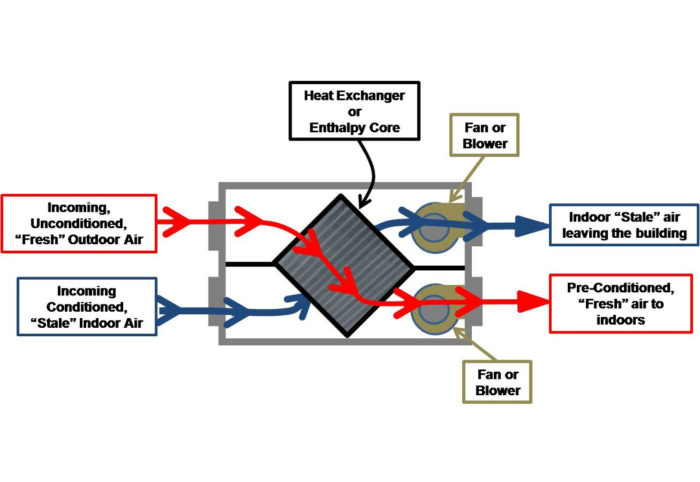The All-Inclusive Overview to the Uses of Heat Recovery Ventilation in Modern Structures
Heat Recovery Ventilation (HRV) systems stand for a significant innovation in building innovation (HRV Heat Recovery Ventilation). They offer an approach for exchanging stale indoor air with fresh exterior air while lessening power loss. This strategy not just enhances indoor air high quality but also adds to energy effectiveness in both residential and commercial structures. Comprehending the different applications and advantages of HRV can expose its vital function in modern-day style and sustainability efforts. The effects of this technology deserve checking out even more
Comprehending Heat Recovery Ventilation Systems

Numerous contemporary structures prioritize power efficiency, recognizing warmth recovery ventilation (HRV) systems is essential for maximizing interior air high quality and lowering energy consumption. HRV systems work by transferring warmth from stagnant interior air to incoming fresh air, efficiently keeping comfortable indoor temperatures while lessening power loss. These systems include a warm exchanger, fans, and ductwork that help with the circulation of air. Throughout winter, HRV systems capture and recycle warm from the outbound air, while in summertime, they can assist cool down incoming air. By constantly trading air, HRV systems additionally lower moisture and the concentration of interior contaminants. Correct installment and maintenance of HRV systems are vital for their performance and effectiveness in improving general building performance and comfort.
Advantages of Heat Recovery Ventilation
Heat recovery ventilation systems supply countless benefits that boost both energy efficiency and interior air high quality in modern-day structures. By recording and recycling power from exhaust air, these systems considerably lower home heating and cooling expenses, leading to lower energy intake. In addition, they keep a constant circulation of fresh exterior air, minimizing the danger of indoor air pollutants and allergens. This continual exchange aids manage moisture degrees, stopping mold development and ensuring a much healthier living atmosphere. In addition, HRV systems add to sustainability objectives by reducing total carbon impacts. Their capacity to enhance ventilation without compromising thermal comfort makes them a valuable addition to modern building style, promoting both financial and environmental benefits.
Applications of HRV in Residential Buildings
As homeowners progressively focus on energy performance and interior air high quality, the applications of warmth recovery ventilation (HRV) systems in domestic buildings have ended up being more common. HRV systems are particularly useful in firmly secured homes, where keeping fresh air circulation is important for stopping dampness build-up and interior pollutants. They successfully move heat from outward bound stale air to inbound fresh air, decreasing power prices related to heating and cooling. Additionally, HRVs can enhance convenience degrees by controling moisture and temperature. They are likewise versatile for different household styles, including single-family find out here now homes and multi-unit structures. On the whole, incorporating HRV systems sustains lasting living techniques while guaranteeing a much healthier interior setting for passengers.
HRV in Business and Industrial Settings
In business and industrial setups, the application of warm healing ventilation (HRV) systems has actually ended up being significantly critical for maximizing energy efficiency and maintaining air high quality. These systems properly move warmth from exhaust air to inbound fresh air, lowering the demand for additional home heating or air conditioning. This not only reduces energy expenses yet likewise adds to sustainability efforts. Industries such as manufacturing, warehousing, and office complex profit greatly from HRV systems, as they aid manage temperature and moisture levels, guaranteeing a comfortable and effective atmosphere. Additionally, HRV systems help in eliminating contaminants and excess wetness, enhancing indoor air top quality. As guidelines around air high quality end up being more stringent, the fostering of HRV innovation is likely to expand, making it a critical element of modern industrial and industrial framework.
Future Trends in Heat Recovery Ventilation Modern Technology

Often Asked Questions
How Does Heat Recovery Ventilation Impact Indoor Air High Quality?
Heat recovery ventilation significantly boosts interior air top quality by continuously trading stagnant indoor air with fresh exterior air while recuperating power. This process minimizes toxins, preserves optimal humidity levels, and ensures a healthier setting for occupants.
Can HRV Solutions Be Installed in Existing Structures?
HRV systems can certainly be mounted in existing structures. Retrofitting might require modifications to ductwork and air flow designs, however it considerably improves power efficiency and indoor air quality, making it a feasible alternative for older structures.
What Maintenance Is Required for HRV Systems?

Exist Certain Climates Where HRV Is More Efficient?
Heat recovery ventilation systems are particularly Look At This efficient in climates with substantial temperature level differences between seasons. These systems enhance power effectiveness by recouping warmth from exhaust air, making them optimal for both cool and reasonably warm environments.
Just How Do HRV Systems Affect Power Bills?
